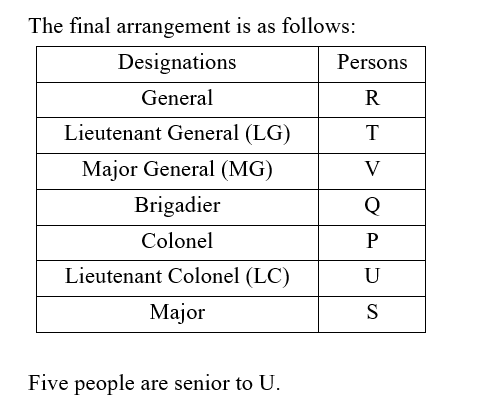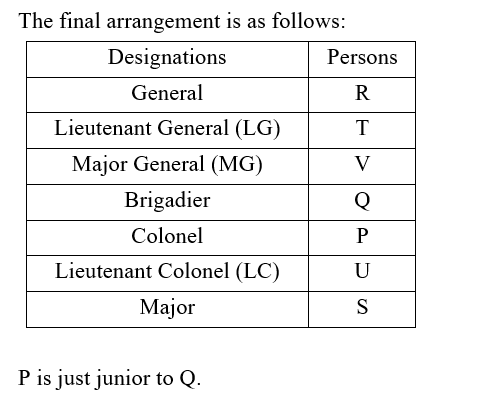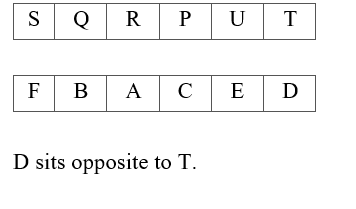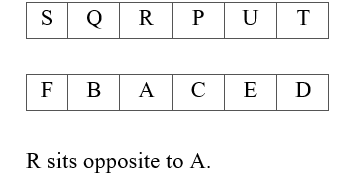Question 1:
Direction : Answer the questions based on the information given below.
निर्देश : नीचे दी गई जानकारी के आधार पर प्रश्नों के उत्तर दें।
Seven people P, Q, R, S, T, U, and V posted in seven different ranks in the Indian Army i.e., General, Lieutenant General (LG), Major General (MG), Brigadier, Colonel, Lieutenant Colonel (LC) and Major but not in the same order. Also, ranks are given in descending order such that General being the senior-most post and Major being the junior-most post among the given posts of Indian Army.
Note: If it is given that X is senior to Y then it means X ranks in a higher post than Y.
R is senior to the one, who is the Brigadier. More than two designations are there between R and P, who is not LC. There is only one person in the hierarchy between P and S. Number of people designated between R and Q is same as the number of people designated between Q and S. U is junior to V. Q is not the LG. Only one person is designated between Q and T, who is senior to V.
सात लोग P, Q, R, S, T, U, और V भारतीय सेना में सात अलग-अलग रैंकों में तैनात हैं अर्थात जनरल, लेफ्टिनेंट जनरल (LG), मेजर जनरल (MG), ब्रिगेडियर, कर्नल, लेफ्टिनेंट कर्नल (LC) और मेजर लेकिन ये आवश्यक नहीं कि समान क्रम में इसके अलावा, रैंक अवरोही क्रम में दी गई हैं जहाँ भारतीय सेना में दिए गए पदों में से जनरल सबसे वरिष्ठ पद है और मेजर सबसे कनिष्ठ पद है।
ध्यान दें:
यदि यह ज्ञात है कि X, Y से वरिष्ठ है तो इसका अर्थ है कि X, Y से उच्च पद पर है।
R उस व्यक्ति से वरिष्ठ है, जो ब्रिगेडियर है। R और P के बीच दो से अधिक पद हैं और P, LC नहीं है। P और S के बीच पदानुक्रम में केवल एक व्यक्ति है। R और Q के बीच पदानुक्रम में व्यक्तियों की संख्या और Q और S के बीच पदानुक्रम में व्यक्तियों की संख्या समान है। U, V से कनिष्ठ है। Q, LG नहीं है। Q और T जो V से वरिष्ठ है, के बीच केवल एक व्यक्ति को नामित किया गया है।
Who among the following posted as MG?
निम्नलिखित में से किसका पद MG है?
Question 2:
Direction : Answer the questions based on the information given below.
निर्देश : नीचे दी गई जानकारी के आधार पर प्रश्नों के उत्तर दें।
Seven people P, Q, R, S, T, U, and V posted in seven different ranks in the Indian Army i.e., General, Lieutenant General (LG), Major General (MG), Brigadier, Colonel, Lieutenant Colonel (LC) and Major but not in the same order. Also, ranks are given in descending order such that General being the senior-most post and Major being the junior-most post among the given posts of Indian Army.
Note: If it is given that X is senior to Y then it means X ranks in a higher post than Y.
R is senior to the one, who is the Brigadier. More than two designations are there between R and P, who is not LC. There is only one person in the hierarchy between P and S. Number of people designated between R and Q is same as the number of people designated between Q and S. U is junior to V. Q is not the LG. Only one person is designated between Q and T, who is senior to V.
सात लोग P, Q, R, S, T, U, और V भारतीय सेना में सात अलग-अलग रैंकों में तैनात हैं अर्थात जनरल, लेफ्टिनेंट जनरल (LG), मेजर जनरल (MG), ब्रिगेडियर, कर्नल, लेफ्टिनेंट कर्नल (LC) और मेजर लेकिन ये आवश्यक नहीं कि समान क्रम में इसके अलावा, रैंक अवरोही क्रम में दी गई हैं जहाँ भारतीय सेना में दिए गए पदों में से जनरल सबसे वरिष्ठ पद है और मेजर सबसे कनिष्ठ पद है।
ध्यान दें:
यदि यह ज्ञात है कि X, Y से वरिष्ठ है तो इसका अर्थ है कि X, Y से उच्च पद पर है।
R उस व्यक्ति से वरिष्ठ है, जो ब्रिगेडियर है। R और P के बीच दो से अधिक पद हैं और P, LC नहीं है। P और S के बीच पदानुक्रम में केवल एक व्यक्ति है। R और Q के बीच पदानुक्रम में व्यक्तियों की संख्या और Q और S के बीच पदानुक्रम में व्यक्तियों की संख्या समान है। U, V से कनिष्ठ है। Q, LG नहीं है। Q और T जो V से वरिष्ठ है, के बीच केवल एक व्यक्ति को नामित किया गया है।
How many people are senior to U?
कितने व्यक्ति U से वरिष्ठ हैं?
Question 3:
Direction : Answer the questions based on the information given below.
निर्देश : नीचे दी गई जानकारी के आधार पर प्रश्नों के उत्तर दें।
Seven people P, Q, R, S, T, U, and V posted in seven different ranks in the Indian Army i.e., General, Lieutenant General (LG), Major General (MG), Brigadier, Colonel, Lieutenant Colonel (LC) and Major but not in the same order. Also, ranks are given in descending order such that General being the senior-most post and Major being the junior-most post among the given posts of Indian Army.
Note: If it is given that X is senior to Y then it means X ranks in a higher post than Y.
R is senior to the one, who is the Brigadier. More than two designations are there between R and P, who is not LC. There is only one person in the hierarchy between P and S. Number of people designated between R and Q is same as the number of people designated between Q and S. U is junior to V. Q is not the LG. Only one person is designated between Q and T, who is senior to V.
सात लोग P, Q, R, S, T, U, और V भारतीय सेना में सात अलग-अलग रैंकों में तैनात हैं अर्थात जनरल, लेफ्टिनेंट जनरल (LG), मेजर जनरल (MG), ब्रिगेडियर, कर्नल, लेफ्टिनेंट कर्नल (LC) और मेजर लेकिन ये आवश्यक नहीं कि समान क्रम में इसके अलावा, रैंक अवरोही क्रम में दी गई हैं जहाँ भारतीय सेना में दिए गए पदों में से जनरल सबसे वरिष्ठ पद है और मेजर सबसे कनिष्ठ पद है।
ध्यान दें:
यदि यह ज्ञात है कि X, Y से वरिष्ठ है तो इसका अर्थ है कि X, Y से उच्च पद पर है।
R उस व्यक्ति से वरिष्ठ है, जो ब्रिगेडियर है। R और P के बीच दो से अधिक पद हैं और P, LC नहीं है। P और S के बीच पदानुक्रम में केवल एक व्यक्ति है। R और Q के बीच पदानुक्रम में व्यक्तियों की संख्या और Q और S के बीच पदानुक्रम में व्यक्तियों की संख्या समान है। U, V से कनिष्ठ है। Q, LG नहीं है। Q और T जो V से वरिष्ठ है, के बीच केवल एक व्यक्ति को नामित किया गया है।
Who among the following is just junior to Q?
निम्नलिखित में से कौन Q से तत्काल कनिष्ठ है?
Question 4:
Direction : Answer the questions based on the information given below.
निर्देश : नीचे दी गई जानकारी के आधार पर प्रश्नों के उत्तर दें।
Seven people P, Q, R, S, T, U, and V posted in seven different ranks in the Indian Army i.e., General, Lieutenant General (LG), Major General (MG), Brigadier, Colonel, Lieutenant Colonel (LC) and Major but not in the same order. Also, ranks are given in descending order such that General being the senior-most post and Major being the junior-most post among the given posts of Indian Army.
Note: If it is given that X is senior to Y then it means X ranks in a higher post than Y.
R is senior to the one, who is the Brigadier. More than two designations are there between R and P, who is not LC. There is only one person in the hierarchy between P and S. Number of people designated between R and Q is same as the number of people designated between Q and S. U is junior to V. Q is not the LG. Only one person is designated between Q and T, who is senior to V.
सात लोग P, Q, R, S, T, U, और V भारतीय सेना में सात अलग-अलग रैंकों में तैनात हैं अर्थात जनरल, लेफ्टिनेंट जनरल (LG), मेजर जनरल (MG), ब्रिगेडियर, कर्नल, लेफ्टिनेंट कर्नल (LC) और मेजर लेकिन ये आवश्यक नहीं कि समान क्रम में इसके अलावा, रैंक अवरोही क्रम में दी गई हैं जहाँ भारतीय सेना में दिए गए पदों में से जनरल सबसे वरिष्ठ पद है और मेजर सबसे कनिष्ठ पद है।
ध्यान दें:
यदि यह ज्ञात है कि X, Y से वरिष्ठ है तो इसका अर्थ है कि X, Y से उच्च पद पर है।
R उस व्यक्ति से वरिष्ठ है, जो ब्रिगेडियर है। R और P के बीच दो से अधिक पद हैं और P, LC नहीं है। P और S के बीच पदानुक्रम में केवल एक व्यक्ति है। R और Q के बीच पदानुक्रम में व्यक्तियों की संख्या और Q और S के बीच पदानुक्रम में व्यक्तियों की संख्या समान है। U, V से कनिष्ठ है। Q, LG नहीं है। Q और T जो V से वरिष्ठ है, के बीच केवल एक व्यक्ति को नामित किया गया है।
Who is posted as the Brigadier?
ब्रिगेडियर के पद पर कौन तैनात है?
Question 5:
Direction : Answer the questions based on the information given below.
निर्देश : नीचे दी गई जानकारी के आधार पर प्रश्नों के उत्तर दें।
Seven people P, Q, R, S, T, U, and V posted in seven different ranks in the Indian Army i.e., General, Lieutenant General (LG), Major General (MG), Brigadier, Colonel, Lieutenant Colonel (LC) and Major but not in the same order. Also, ranks are given in descending order such that General being the senior-most post and Major being the junior-most post among the given posts of Indian Army.
Note: If it is given that X is senior to Y then it means X ranks in a higher post than Y.
R is senior to the one, who is the Brigadier. More than two designations are there between R and P, who is not LC. There is only one person in the hierarchy between P and S. Number of people designated between R and Q is same as the number of people designated between Q and S. U is junior to V. Q is not the LG. Only one person is designated between Q and T, who is senior to V.
सात लोग P, Q, R, S, T, U, और V भारतीय सेना में सात अलग-अलग रैंकों में तैनात हैं अर्थात जनरल, लेफ्टिनेंट जनरल (LG), मेजर जनरल (MG), ब्रिगेडियर, कर्नल, लेफ्टिनेंट कर्नल (LC) और मेजर लेकिन ये आवश्यक नहीं कि समान क्रम में इसके अलावा, रैंक अवरोही क्रम में दी गई हैं जहाँ भारतीय सेना में दिए गए पदों में से जनरल सबसे वरिष्ठ पद है और मेजर सबसे कनिष्ठ पद है।
ध्यान दें:
यदि यह ज्ञात है कि X, Y से वरिष्ठ है तो इसका अर्थ है कि X, Y से उच्च पद पर है।
R उस व्यक्ति से वरिष्ठ है, जो ब्रिगेडियर है। R और P के बीच दो से अधिक पद हैं और P, LC नहीं है। P और S के बीच पदानुक्रम में केवल एक व्यक्ति है। R और Q के बीच पदानुक्रम में व्यक्तियों की संख्या और Q और S के बीच पदानुक्रम में व्यक्तियों की संख्या समान है। U, V से कनिष्ठ है। Q, LG नहीं है। Q और T जो V से वरिष्ठ है, के बीच केवल एक व्यक्ति को नामित किया गया है।
How many people are in the hierarchy between R and S?.
R और S के बीच पदानुक्रम में कितने व्यक्ति हैं?
Question 6:
Directions : Answer the questions based on the information given below.
12 persons are sitting in two parallel rows such that six persons sit in each row. P, Q, R, S, T and U sit in row 1 while A, B, C, D, E and F sit in row 2. Persons in both the rows face each other. Persons in row 1 face south while persons in row 2 face north.
P sits second to the right of T but not on any extreme end. S is not adjacent to P.Q sits third to the right of U, who sits opposite to E, who sits immediate left of D. One person sits between D and C.F sits immediate left of B but not opposite to Q.
12 व्यक्ति दो सामानांतर पंक्ति में इस तरह बैठे है कि प्रत्येक पंक्ति में छह व्यक्ति बैठे हैं।P, Q, R, S, T और U पंक्ति 1 में बैठे हैं जबकि A, B, C, D, E और F पंक्ति 2 में बैठे हैं।दोनों पंक्ति में बैठे व्यक्ति एक दूसरे का सामना करते हैं।पंक्ति 1 में बैठे व्यक्ति दक्षिण का सामना करते हैं जबकि पंक्ति 2 में बैठे व्यक्ति उत्तर का सामना करते हैं।
P, T के दाएँ से दूसरे स्थान पर बैठा है पर किसी अंतिम छोर पर नहीं। S, P के बगल में नहीं है। Q, U के दाएँ से तीसरे स्थान पर बैठा है और U, E के विपरीत बैठा है और E D के तत्काल बाएं ओर बैठा है। एक व्यक्ति D और C के बीच बैठे है। F, B के तत्काल बाएं ओर बैठा है पर Q के विपरीत नहीं।
Find the odd one out.
विषम का चुनाव करें।
Question 7:
Directions : Answer the questions based on the information given below.
12 persons are sitting in two parallel rows such that six persons sit in each row. P, Q, R, S, T and U sit in row 1 while A, B, C, D, E and F sit in row 2. Persons in both the rows face each other. Persons in row 1 face south while persons in row 2 face north.
P sits second to the right of T but not on any extreme end. S is not adjacent to P.Q sits third to the right of U, who sits opposite to E, who sits immediate left of D. One person sits between D and C.F sits immediate left of B but not opposite to Q.
12 व्यक्ति दो सामानांतर पंक्ति में इस तरह बैठे है कि प्रत्येक पंक्ति में छह व्यक्ति बैठे हैं।P, Q, R, S, T और U पंक्ति 1 में बैठे हैं जबकि A, B, C, D, E और F पंक्ति 2 में बैठे हैं।दोनों पंक्ति में बैठे व्यक्ति एक दूसरे का सामना करते हैं।पंक्ति 1 में बैठे व्यक्ति दक्षिण का सामना करते हैं जबकि पंक्ति 2 में बैठे व्यक्ति उत्तर का सामना करते हैं।
P, T के दाएँ से दूसरे स्थान पर बैठा है पर किसी अंतिम छोर पर नहीं। S, P के बगल में नहीं है। Q, U के दाएँ से तीसरे स्थान पर बैठा है और U, E के विपरीत बैठा है और E D के तत्काल बाएं ओर बैठा है। एक व्यक्ति D और C के बीच बैठे है। F, B के तत्काल बाएं ओर बैठा है पर Q के विपरीत नहीं।
Who sits immediate right of C?
C के तत्काल दाएँ ओर कौन बैठा है?
Question 8:
Directions : Answer the questions based on the information given below.
12 persons are sitting in two parallel rows such that six persons sit in each row. P, Q, R, S, T and U sit in row 1 while A, B, C, D, E and F sit in row 2. Persons in both the rows face each other. Persons in row 1 face south while persons in row 2 face north.
P sits second to the right of T but not on any extreme end. S is not adjacent to P.Q sits third to the right of U, who sits opposite to E, who sits immediate left of D. One person sits between D and C.F sits immediate left of B but not opposite to Q.
12 व्यक्ति दो सामानांतर पंक्ति में इस तरह बैठे है कि प्रत्येक पंक्ति में छह व्यक्ति बैठे हैं।P, Q, R, S, T और U पंक्ति 1 में बैठे हैं जबकि A, B, C, D, E और F पंक्ति 2 में बैठे हैं।दोनों पंक्ति में बैठे व्यक्ति एक दूसरे का सामना करते हैं।पंक्ति 1 में बैठे व्यक्ति दक्षिण का सामना करते हैं जबकि पंक्ति 2 में बैठे व्यक्ति उत्तर का सामना करते हैं।
P, T के दाएँ से दूसरे स्थान पर बैठा है पर किसी अंतिम छोर पर नहीं। S, P के बगल में नहीं है। Q, U के दाएँ से तीसरे स्थान पर बैठा है और U, E के विपरीत बैठा है और E D के तत्काल बाएं ओर बैठा है। एक व्यक्ति D और C के बीच बैठे है। F, B के तत्काल बाएं ओर बैठा है पर Q के विपरीत नहीं।
Who sits opposite to T?
T के विपरीत कौन बैठा है?
Question 9:
Directions : Answer the questions based on the information given below.
12 persons are sitting in two parallel rows such that six persons sit in each row. P, Q, R, S, T and U sit in row 1 while A, B, C, D, E and F sit in row 2. Persons in both the rows face each other. Persons in row 1 face south while persons in row 2 face north.
P sits second to the right of T but not on any extreme end. S is not adjacent to P.Q sits third to the right of U, who sits opposite to E, who sits immediate left of D. One person sits between D and C.F sits immediate left of B but not opposite to Q.
12 व्यक्ति दो सामानांतर पंक्ति में इस तरह बैठे है कि प्रत्येक पंक्ति में छह व्यक्ति बैठे हैं।P, Q, R, S, T और U पंक्ति 1 में बैठे हैं जबकि A, B, C, D, E और F पंक्ति 2 में बैठे हैं।दोनों पंक्ति में बैठे व्यक्ति एक दूसरे का सामना करते हैं।पंक्ति 1 में बैठे व्यक्ति दक्षिण का सामना करते हैं जबकि पंक्ति 2 में बैठे व्यक्ति उत्तर का सामना करते हैं।
P, T के दाएँ से दूसरे स्थान पर बैठा है पर किसी अंतिम छोर पर नहीं। S, P के बगल में नहीं है। Q, U के दाएँ से तीसरे स्थान पर बैठा है और U, E के विपरीत बैठा है और E D के तत्काल बाएं ओर बैठा है। एक व्यक्ति D और C के बीच बैठे है। F, B के तत्काल बाएं ओर बैठा है पर Q के विपरीत नहीं।
Who sits immediate right of Q?
Q के तत्काल दाएँ ओर कौन बैठा है?
Question 10:
Directions : Answer the questions based on the information given below.
12 persons are sitting in two parallel rows such that six persons sit in each row. P, Q, R, S, T and U sit in row 1 while A, B, C, D, E and F sit in row 2. Persons in both the rows face each other. Persons in row 1 face south while persons in row 2 face north.
P sits second to the right of T but not on any extreme end. S is not adjacent to P.Q sits third to the right of U, who sits opposite to E, who sits immediate left of D. One person sits between D and C.F sits immediate left of B but not opposite to Q.
12 व्यक्ति दो सामानांतर पंक्ति में इस तरह बैठे है कि प्रत्येक पंक्ति में छह व्यक्ति बैठे हैं।P, Q, R, S, T और U पंक्ति 1 में बैठे हैं जबकि A, B, C, D, E और F पंक्ति 2 में बैठे हैं।दोनों पंक्ति में बैठे व्यक्ति एक दूसरे का सामना करते हैं।पंक्ति 1 में बैठे व्यक्ति दक्षिण का सामना करते हैं जबकि पंक्ति 2 में बैठे व्यक्ति उत्तर का सामना करते हैं।
P, T के दाएँ से दूसरे स्थान पर बैठा है पर किसी अंतिम छोर पर नहीं। S, P के बगल में नहीं है। Q, U के दाएँ से तीसरे स्थान पर बैठा है और U, E के विपरीत बैठा है और E D के तत्काल बाएं ओर बैठा है। एक व्यक्ति D और C के बीच बैठे है। F, B के तत्काल बाएं ओर बैठा है पर Q के विपरीत नहीं।
_____ sits opposite to A.
____ A के विपरीत बैठा है?










